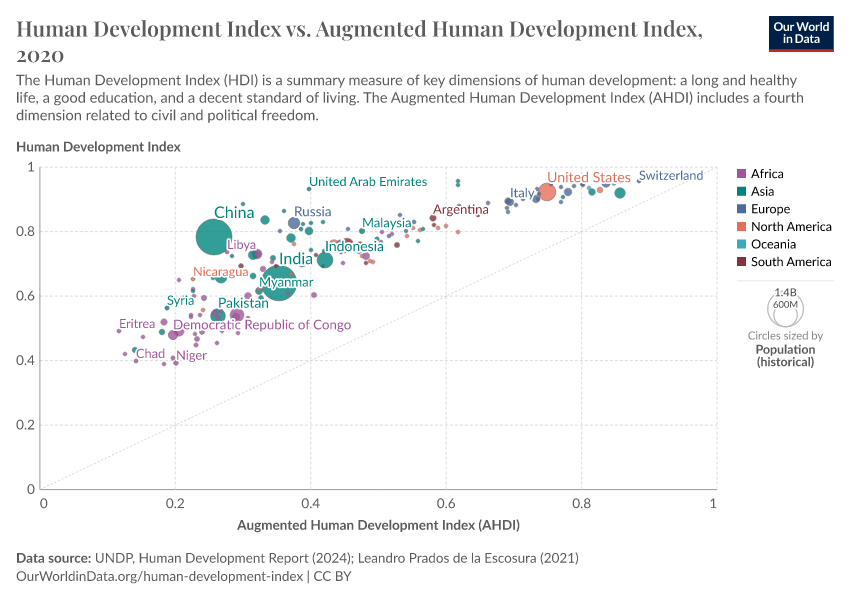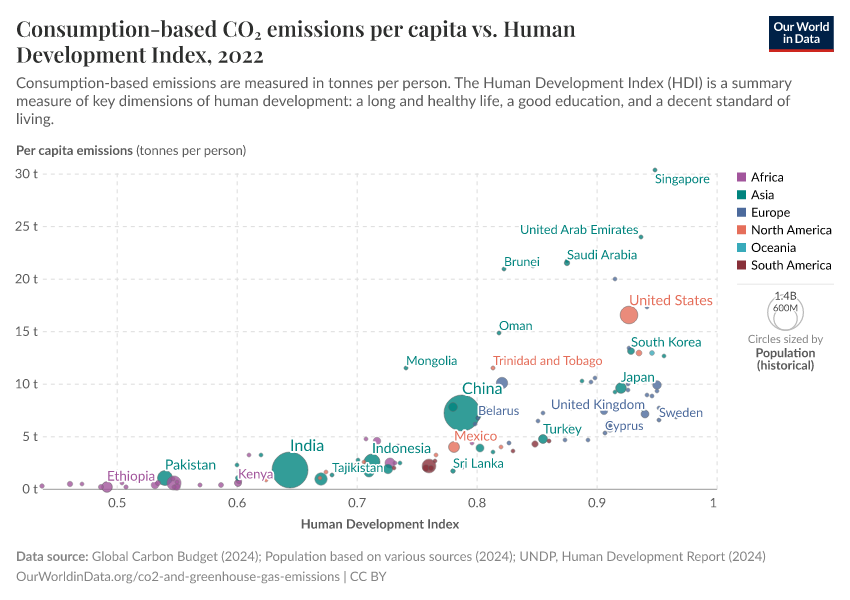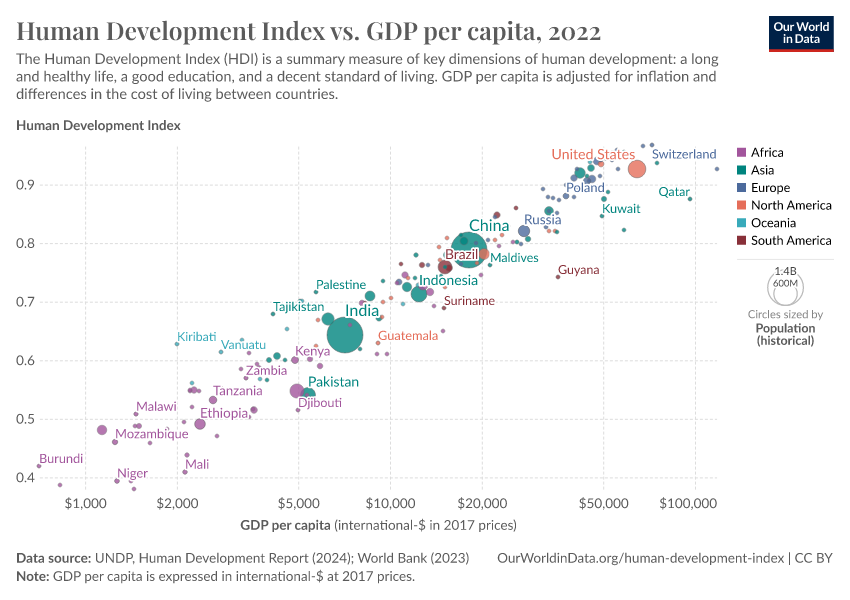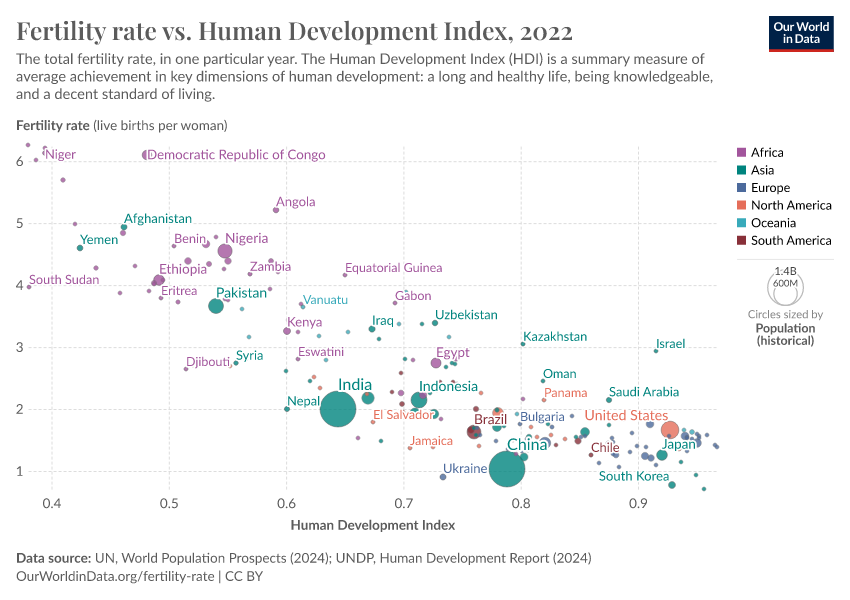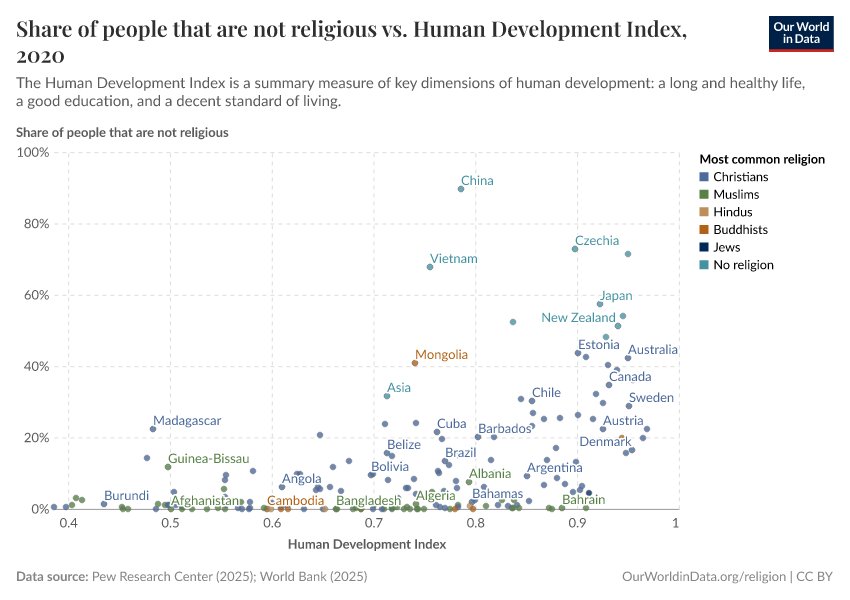Human Development Index
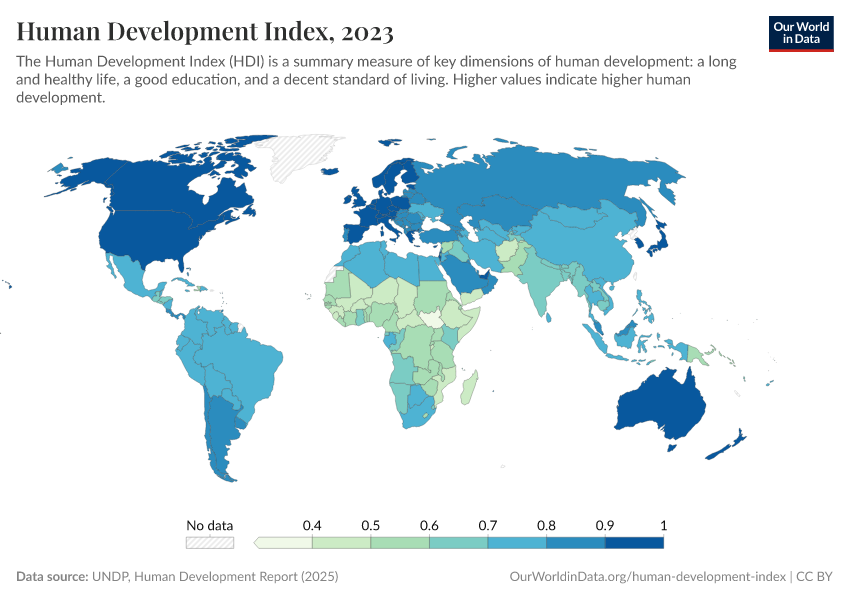
What you should know about this indicator
- The Human Development Index (HDI) provides a broad, intuitive measure for comparing overall human progress across countries and over time. A higher HDI implies longer, healthier lives, better education and higher command over resources; however, it does not capture inequality, sustainability or subjective wellbeing
- It is a composite summary of a country's average achievement in three basic dimensions of human development – health (life expectancy), knowledge (schooling) and material wellbeing (GNI per capita) – combined through a geometric mean into a single 0‑to‑1 score.
- Each dimension of the HDI is captured by a specific index:
- Healthy life: Captured by the Life Expectancy Index, which is based on life expectancy at birth.
- Good education (knowledge): Captured by Education Index, which is based on the expected and mean years of schooling.
- Decent standard of living: Captured by Gross National Income (GNI) Index, which is based on the GNI per capita (PPP$).
- The index is estimated by normalizing and aggregating the above indicators. First, the indicators are brought onto the same scale, ranging from 0 to 1. This is done by setting minimum and maximum values for each indicator. The minimum and maximum values for each indicator are defined as follows:
- Life expectancy at birth ranges between 20 and 85 years
- Expected years of schooling between 0 and 18 years; Mean years of schooling, between 0 and 15 years
- GNI per capita between 100 and 75,000 international-$ at 2021 prices.
- The HDI is then estimated as the geometric mean of these indices. The education index is the arithmetic mean (average) of the mean years of schooling and expected years of schooling.
Related research and writing
What you should know about this indicator
- The Human Development Index (HDI) provides a broad, intuitive measure for comparing overall human progress across countries and over time. A higher HDI implies longer, healthier lives, better education and higher command over resources; however, it does not capture inequality, sustainability or subjective wellbeing
- It is a composite summary of a country's average achievement in three basic dimensions of human development – health (life expectancy), knowledge (schooling) and material wellbeing (GNI per capita) – combined through a geometric mean into a single 0‑to‑1 score.
- Each dimension of the HDI is captured by a specific index:
- Healthy life: Captured by the Life Expectancy Index, which is based on life expectancy at birth.
- Good education (knowledge): Captured by Education Index, which is based on the expected and mean years of schooling.
- Decent standard of living: Captured by Gross National Income (GNI) Index, which is based on the GNI per capita (PPP$).
- The index is estimated by normalizing and aggregating the above indicators. First, the indicators are brought onto the same scale, ranging from 0 to 1. This is done by setting minimum and maximum values for each indicator. The minimum and maximum values for each indicator are defined as follows:
- Life expectancy at birth ranges between 20 and 85 years
- Expected years of schooling between 0 and 18 years; Mean years of schooling, between 0 and 15 years
- GNI per capita between 100 and 75,000 international-$ at 2021 prices.
- The HDI is then estimated as the geometric mean of these indices. The education index is the arithmetic mean (average) of the mean years of schooling and expected years of schooling.
Sources and processing
This data is based on the following sources
How we process data at Our World in Data
All data and visualizations on Our World in Data rely on data sourced from one or several original data providers. Preparing this original data involves several processing steps. Depending on the data, this can include standardizing country names and world region definitions, converting units, calculating derived indicators such as per capita measures, as well as adding or adapting metadata such as the name or the description given to an indicator.
At the link below you can find a detailed description of the structure of our data pipeline, including links to all the code used to prepare data across Our World in Data.
Reuse this work
- All data produced by third-party providers and made available by Our World in Data are subject to the license terms from the original providers. Our work would not be possible without the data providers we rely on, so we ask you to always cite them appropriately (see below). This is crucial to allow data providers to continue doing their work, enhancing, maintaining and updating valuable data.
- All data, visualizations, and code produced by Our World in Data are completely open access under the Creative Commons BY license. You have the permission to use, distribute, and reproduce these in any medium, provided the source and authors are credited.
Citations
How to cite this page
To cite this page overall, including any descriptions, FAQs or explanations of the data authored by Our World in Data, please use the following citation:
“Data Page: Human Development Index”, part of the following publication: Bastian Herre and Pablo Arriagada (2023) - “The Human Development Index and related indices: what they are and what we can learn from them”. Data adapted from UNDP, Human Development Report. Retrieved from https://archive.ourworldindata.org/20251209-133038/grapher/human-development-index.html [online resource] (archived on December 9, 2025).How to cite this data
In-line citationIf you have limited space (e.g. in data visualizations), you can use this abbreviated in-line citation:
UNDP, Human Development Report (2025) – with minor processing by Our World in DataFull citation
UNDP, Human Development Report (2025) – with minor processing by Our World in Data. “Human Development Index – UNDP” [dataset]. UNDP, Human Development Report, “Human Development Report” [original data]. Retrieved December 12, 2025 from https://archive.ourworldindata.org/20251209-133038/grapher/human-development-index.html (archived on December 9, 2025).